Access all athletes: This summer’s trend for getting closer to the action
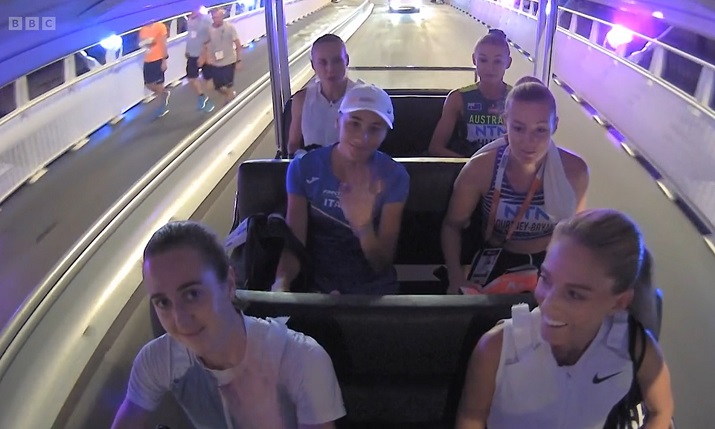
Athletes at the World Athletics Championships in Budapest
Getting audiences closer to athletes is an ongoing aim of broadcasters and production teams. And, with on-demand streaming platforms awash with sports documentaries that take viewers behind the scenes, the push for improved access is greater than ever. SVG Europe rounds up some of this summer’s advances.
This summer there have been some significant advances in the drive to get viewers closer to the action, with some of the more conservative competitions and tournaments easing restrictions and providing broadcasters with improved access.
This year’s Wimbledon Championships was one such example. Wimbledon Broadcast Services (WBS) head of broadcast Paul Davies explained to SVG Europe: “Broadcasters are paying very decent rights fees, and perhaps not being afforded the same privileges, which WBS and wider AELTC is very sympathetic to. That easing up of access, which had been quite guarded in previous years, I think the club is getting more comfortable with. And, the players are more familiar with cameras behind the scenes.”
For Wimbledon, that led WBS and new production partner Whisper to create ‘Access all England’, a daily, linear offering of behind-the-scenes content that ran from 9am to 5pm with feeds from around 35 behind-the-scenes and beauty cameras to avoid players being “lost” to broadcasters once they enter the building.
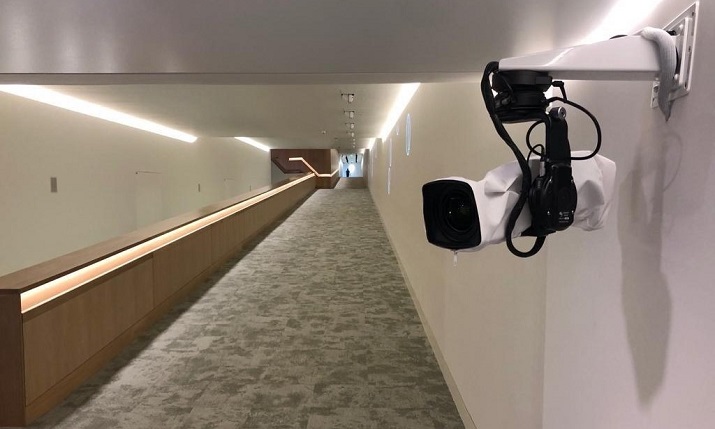
“The beauty of us doing it in house as WBS is we can work with, obviously the club, but also with the players and their representatives. There’s certain environments and situations, where we’re cautious; we don’t show big close ups of people eating, for example,” says Davies.
Taking viewers into previously unseen environments was one of the features of coverage of the World Athletics Championships that took place in Budapest last month.
Speaking to SVG Europe in Budapest, Alastair Waddington, director of ITN Sport and managing director of World Athletics Productions, spoke about how traditional athletics coverage can be.
He said: “It’s a balancing act and occasionally a bit of a challenge to take that forward; you’ve got to preserve everything that’s good about the past but also introduce some innovation.”
In Budapest, small cameras were installed on buggies transporting athletes from their warmup areas to the stadium plus the ‘q Room’ – an area for athletes to sit while they waited to find out if they qualified for the next round – was introduced.
As well as aiding rights holders’ storytelling efforts by providing shots of nervous athletes, it provided some levity when viewers witnessed mischievous event mascot Youhuu emerging from behind one of the sofas to startle Bahamian sprinter Anthonique Strachan.
As with the q Room, cameras in the buggies helped to show the athletes personalities. “You’ll get the athletes that sit and do nothing. You get the athletes that’ll sit and put makeup on, you get athletes that will sit and that’ll high five people as they’re going past them. You get ones that will talk to each other,” Mark Fulton, executive producer for World Athletics Productions, told SVG Europe in Budapest. “It gives you an idea of what an athlete is like.”
They also provided a talking point for broadcasters; BBC anchor Gabby Logan commented on Great Britain athlete Laura Muir being taken to a 1500m event looking very relaxed and waving to camera, using it as a cue to draw in pundits. And, when two of the buggies somehow collided, it provided pictures of the crash and some reassurance that the men’s 200m semi finalists would be ok to compete.
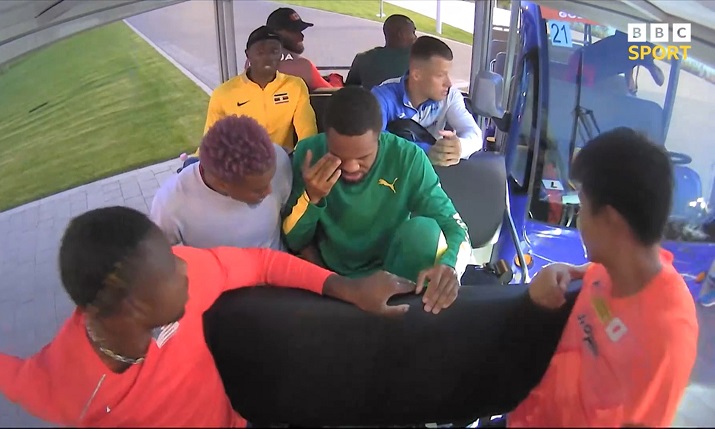
Men’s 200m semi finalists after two buggies collided
A month earlier, at the 151st Open, the biggest on-air addition was the Car Cam, an Atom One Dream Chip camera that was mounted inside the courtesy car that drove the players and others from the driving range to the course.
As with the athletes’ buggies at the World Athletics Championships in Budapest, the camera was positioned in the front of the car to capture a wide shot, without audio, of whoever was being transported during the three-minute drive from the driving range.
Speaking with SVG during the Open, Hamish Greig, director, golf operations, EMG said: “That’s the newest innovation, and the shot is so good, especially if you have three people in the front seat and two in the back seat,” says. “You have a nice full shot. We’ve had flag cams, hole cams, post cams, and all those kinds of things but never a Car Cam. I think it has been such a success that we’ll keep it.”
Audio insights
“I’m gone, I’m dead,” says a clearly exhausted Tadej Pogacar to his UAE Team Emirates teammates on stage 17 of the Tour de France in July. Aired almost in real time and shared with the world, it provided an admission of defeat to his main rival.
In line with what has been done for several years in Formula 1, Tour de France organiser ASO introduced Team Radio to the international broadcast of the Tour de France following a beta version test at last year’s Tour de France Femmes.
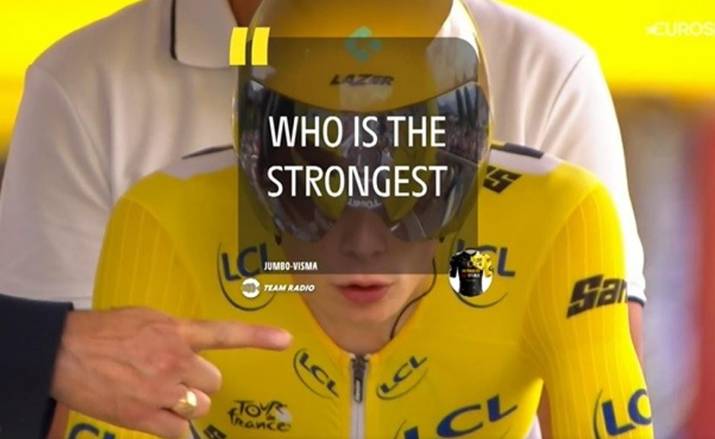
Screenshot of a Team Radio excerpt from the 2023 Tour de France time trial
“This is the innovation of the year,” Guillaume Kleszcz, head of productions and broadcast Services at (ASO) told SVG Europe. The organiser of the Tour de France collaborated with France Télévisions, the host broadcaster, and EMG to set up the technical aspects and convinced 17 out of the 22 teams in the men’s peloton to grant access to previously confidential discussions.
In the end, almost 1,141 Team Radio pieces of content were produced and shared with broadcasters, social networks, and cycling teams during the three weeks of the Tour de France. And, after this initial use, ASO has already indicated its desire to enhance and develop multi-delivery for an even more personalised service to channels.
The goal for ASO is clear: “We want to seek a new audience,” says Kleszcz. “To do that, it’s necessary to better narrate the race, make it more understandable and interesting for viewers.”
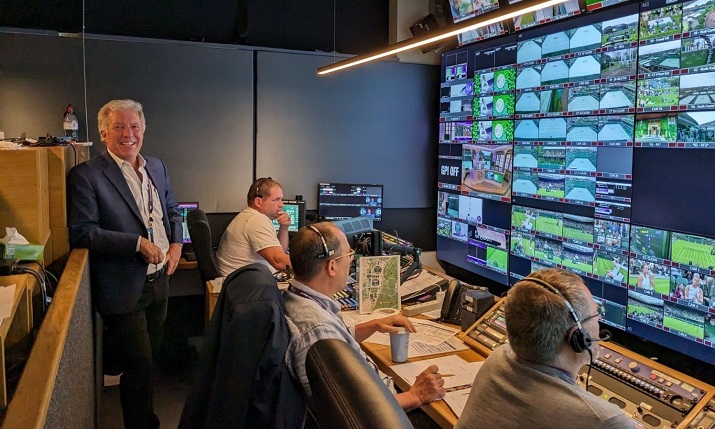
ESPN’s Jamie Reynolds
Hearing directly from the athletes themselves was also a feature of this year’s Wimbledon. Ahead of the start of the Championships, players including Andy Murray and Novak Djokovic were given ear buds connected to a Riedel Bolero wireless intercom system so they could be interviewed during a practice match on Centre Court for content that was made available to rights holders. For WBS and Whisper, inspiration came from the Masters at Augusta, where commentators were able to speak directly with Rory McIlroy.
US rights holder ESPN embraced the concept, mic’ing up players to allow ESPN’s commentary team to conduct interviews with players while they practiced during the tournament. It’s a feature which has also been deployed at the US Open, where Bluetooth headsets are being used to interview players during practice.
“We’ve been very progressive in wanting first-person voices,” ESPN VP production Jamie Reynolds told SVG Europe during the Championships. “We want to hear from the coaches, as well as the players, primarily. And I think with the success that golf has seen this spring [allowing commentators to speak directly with players], we’ve continued to push our approach to talking with players in a live scenario…we want to be able to ask the players about their warm up, to speak with them about their walk to the courts, ask them what the grass feels like, and just have that intimacy and a conversation with somebody in real-time.”
“And it says to our viewers, ‘Hey, we’re talking these players right now, not just waiting for them in the Media Theatre. So that has been our focus coming into this event – how do we keep building a bridge to real-time sound?”
Hearing from athletes on the field of play during a match is something that cricket fans are very much used to, with the likes of the IPL, T20 Blast and this summer’s The Hundred franchise providing commentators with the ability to talk live to players.
Similarly, in the US, Major League Baseball has been a pioneer of mic’ing up and talking to players, with this summer’s MLB All Star game continuing the trend. As the All Star fixture is exhibition match, the rules are relaxed allowing commentators and pundits to speak with the players, and viewers to hear conversations between players.
Pre-season fixtures, away from the strictures of league rules, have provided opportunities for experimentation with football coverage, too. Following last year’s Telekom Cup in Germany during which bodycams provided viewers with a player’s perspective of the action, the same technology was used in July for the Premier League’s Summer Series of pre-season matches in the US.
Reporting by Ken Kerschbaumer, Heather McLean, Alice Boivineau

